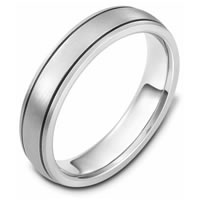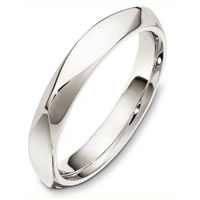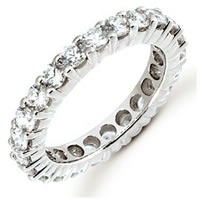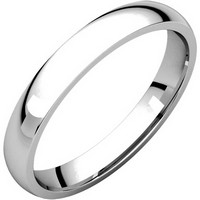
PLATINUM
Platinum is a heavy, malleable, ductile, precious, grey-white metal, is resistant to corrosion and occurs in some nickel and copper ores along with some native deposits.
At WeddingBands.com, we use 95% platinum (950 Platinum) alloyed with 5% ruthenium, iridium or cobalt to manufacture our wedding bands.
Platinum is used in jewelry, laboratory equipment; electrical contacts, dentistry, as well as automobile emissions control devices. Platinum's wear and tarnish-resistance characteristics are well suited for making fine jewelry. Platinum is more precious than gold. In the 18th century, platinum's rarity made King Louis XV of France declare it the only metal fit for a king. Platinum does not oxidize in air at any temperature, but can be corroded by cyanides, halogens, sulfur, and caustic alkalis. This metal is insoluble in hydrochloric and nitric acid, but does dissolve in the mixture known as aqua regia. Platinum was used in ancient Egypt over 3000 years ago. The remarkable metal smiths of that time were extremely skilled in the art of working with platinum. A 2500 year old coffin of an Egyptian High Priestess was discovered, decorated with platinum hieroglyphs. Their polish and luster were still perfect, giving dramatic proof of platinum's incomparable strength and durability. Another ancient people who created adornments from platinum were the Incas. However, the invading Spanish Conquistadors saw little use for this metal, and deemed it "silver of lesser value", platina. They even went so far as to throw great amounts of the metal into the sea, thinking that it might become a cheap imitation for silver.
 During the eighteenth century, platinum's value as a
metal supremely suited for jewelry started to take hold. Then in the nineteenth
century, platinum became the de-facto standard for setting the finest of the
newly discovered gemstone, the diamond. In fact, the most famous of these gems,
the Koh-I-Nor, the Jonker and the Hope diamonds were all set in platinum. Due
to its rarity, platinum is a highly priced metal, more so than gold or silver.
Because it is generally 95% pure (usually alloyed with Iridium or Ruthenium),
platinum jewelry does not fade or tarnish and keeps its looks for a lifetime.
Platinum's purity makes it hypoallergenic and ideal for those with sensitive
skin. Its density and weight make it more durable than other jewelry metals.
During the eighteenth century, platinum's value as a
metal supremely suited for jewelry started to take hold. Then in the nineteenth
century, platinum became the de-facto standard for setting the finest of the
newly discovered gemstone, the diamond. In fact, the most famous of these gems,
the Koh-I-Nor, the Jonker and the Hope diamonds were all set in platinum. Due
to its rarity, platinum is a highly priced metal, more so than gold or silver.
Because it is generally 95% pure (usually alloyed with Iridium or Ruthenium),
platinum jewelry does not fade or tarnish and keeps its looks for a lifetime.
Platinum's purity makes it hypoallergenic and ideal for those with sensitive
skin. Its density and weight make it more durable than other jewelry metals.
Platinum does not wear away and holds precious stones firmly and securely. In addition to its strength and density, platinum has another remarkable quality. Platinum is so pliable, that just one gram of the metal can be drawn to produce a fine wire over one mile (almost 2 km) long. This quality has enabled jewelers to create some amazing versatile platinum mesh accessories, which could not be fashioned from other precious metals.
Platinum is also in demand in other fields, used in industrial fields, most notably in catalytic converters for cars.
Platinum also plays an important role in medicine. It is not affected by the oxidizing reaction of blood, has excellent conductivity, and is compatible with living tissue. Because of these properties, platinum is used for pacemakers.
Physical Properties of Platinum:
Melting point: 2041 degrees K
Symbol: Pt
Crystal System: Face-centered cubic crystal
Hardness: 3.5 Mohs'
Cleavage: None
Fracture: None
Specific Gravity: 21.45
Color: grayish white
Luster: bright, shiny metal
Information
Policies
© Copyright
1995-2025 WeddingBands.com. All rights reserved




